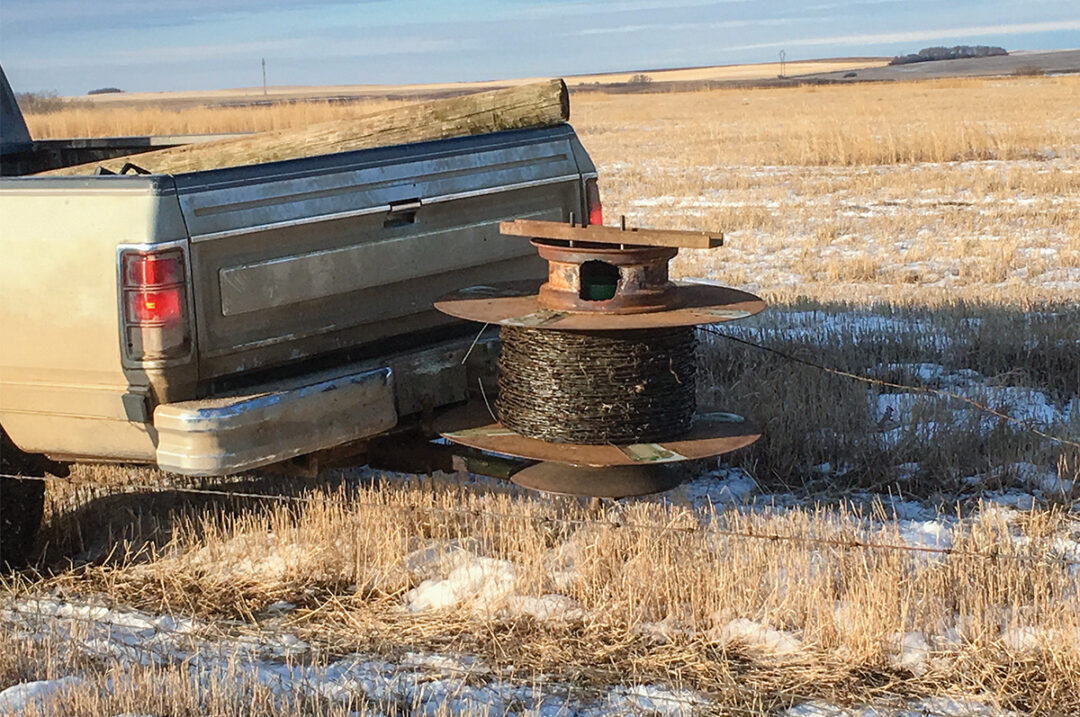Building fence with barbed wire can be a big and sometimes frustrating job. No matter how careful you are, you are going to get snagged on a barb now and again. Trying to unroll a roll of wire by hand is just a nightmare.
I grew up in the Idaho mountains, and the rugged terrain made it difficult to unroll wire. My grandfather came up with the idea to place the roll of wire on a tire with a rim and to drive a stake through the spool, down through the hole in the rim and into the ground. He often had a disc blade on top of the rim to help the roll spin. The stake had to be deep enough to withstand the tension as a person pulled the end of the roll by hand. As a person pulls on the wire, the spool spins on the disc blade on top of the rim and the stake keeps everything in place.
Also, it is easier to pull the wire downhill. This means you have to get the tire, disc blade, stake and roll of wire to the top of the hill, but it is easier than fighting to unroll the wire by hand, especially if you have three or four strands to do.
My husband, Gregory, and I had some fence to build where the terrain was not quite as challenging, so my father-in-law, John, built a very simple unroller we could attach to our truck. He took a piece of square tubing that fit the 2-inch receiving hitch on the truck and drilled a hole in the end to accommodate the pin in the receiving hitch. On the opposite end, he drilled another hole to make a piece of 1-inch sucker rod stand up at a 90-degree angle from the tubing. He then put a piece of old disc spool over the sucker rod for support and then a disc blade on top of the disc spool so the wire roll would spin. He then welded all the pieces together. With this, we were able to attach the end of the wire to a post and then slowly drive to where we needed to be while the wire unrolled behind us.
We were able to acquire some used wire that was still in good shape and had been rolled up with a mechanical wire roller. The wire unroller John had built works great for brand-new wire but doesn’t work for the used wire. The used wire had been rolled up on a conical sphere so it would slip off the device after being tied up. For us to be able to unroll the used wire, we would need something that would be able to keep the roll together and tight as it unrolled.
So John and Gregory expanded upon the first wire unroller. Gregory took an old straw spreader from a John Deere combine, and took the fins off but kept the iron spool that was originally pinned to the hydraulic drive. He then drilled out a 1 1/16-inch hole in the straw spreader so it would fit on top of the existing wire unroller with the 1-inch sucker rod. Next, he cut angular pieces out of the spool portion, pulled the tops together and then welded the pieces together to form a conical shape that would match the mechanical roller and thus fit the roll of used wire.
Gregory then took apart another straw spreader so he had a round, flat piece of iron he could put over the top of the roll of used wire. This would hold the used roll down and in place, but to work properly it needed a spacer to keep it tight as the wire unrolled. Gregory drilled two holes in the bottom of the first straw spreader on opposite sides of the inside of the new cone. He then took two pieces of ready rod and stuck them through the holes and put a nut on the bottom on both the inside and the outside. Gregory then took an old implement tire rim and cut out the spokes and put it on top of the flat iron piece on top of the roll of wire. He put a piece of channel iron over the implement rim and tightened it down with nuts on the ready rods.
Though the unroller may have looked funny, it worked great. It provided the used wire roll with stability and kept the roll tight so the wire wouldn’t snag on a loose coil as it unrolled. Some of the spools of used wire were not rolled as tightly, and so we were able to make adjustments thanks to the ready rods. We were able to tighten or loosen the tension on the rolls as needed to help them unroll without tangling.
With these three different options to be able to unroll wire, we can build fence wherever it is needed and not waste time fighting with the wire.





.jpg?height=auto&t=1713304395&width=285)


